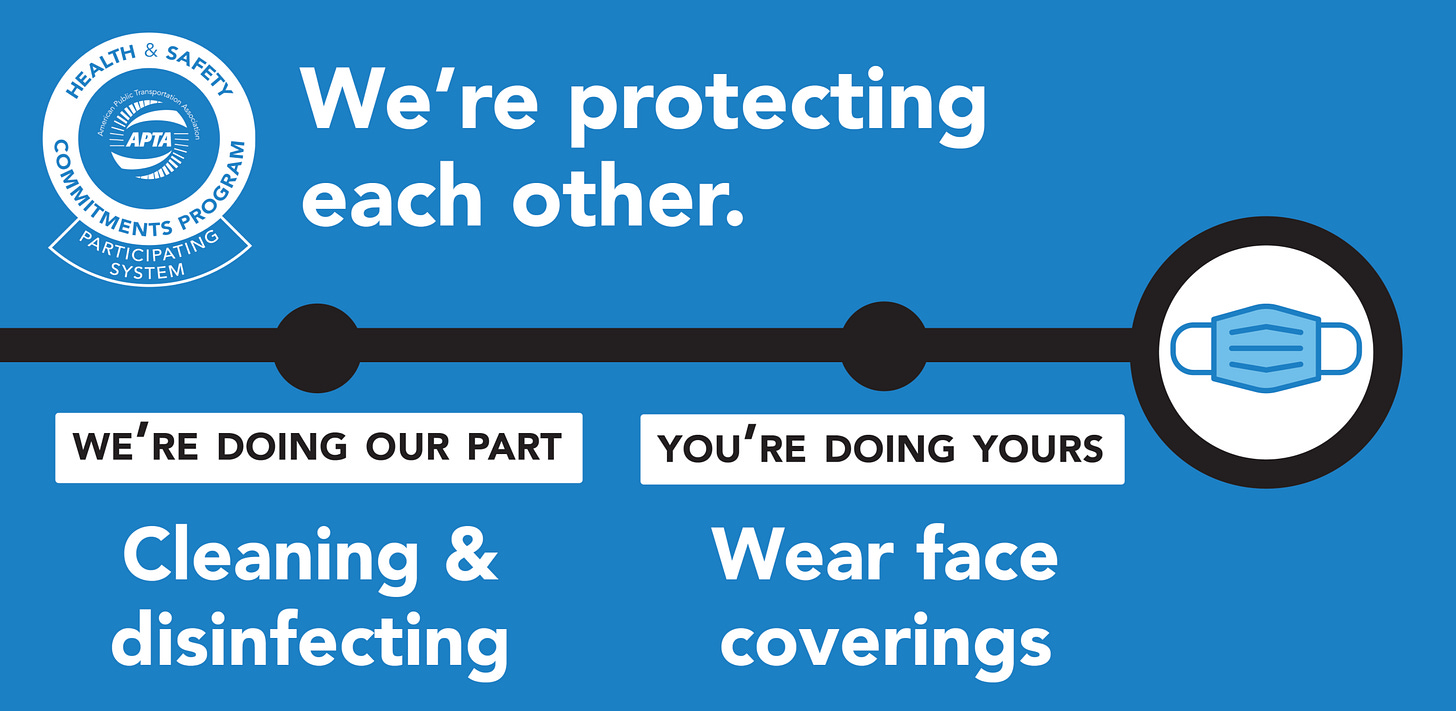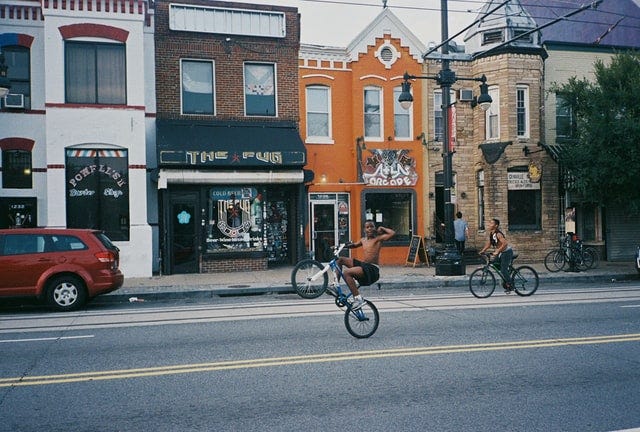MetroNow Dispatch 10.2020
We know you can't focus on anything other than the election but... here's a round-up of transit news that's relevant to you and our region!
Snapshot: Smart Investments for a Stronger Recovery

Photo by Andy Feliciotti on Unsplash
At the start of the pandemic, the Center for Disease Control and Prevention told American employers to encourage employees to avoid transit and drive alone to work if possible. This decision was made out of an abundance of caution before there was data on the relative safety of transit use. Today, we know how to ride transit safely (wear a mask, social distance, wash hands afterwards, and stay quiet), but the CDC messaging fails to recognize the transportation realities of millions of Americans. A car-led approach to the return to work also fails to recognize the environmental and economic impacts of shifting transit commuters to single-occupancy vehicles. A return with more congestion could cost our region billions in lost time and poor health outcomes, and the reduced emissions and improved air quality from the pandemic will be temporary blips if the region turns away from transit. Smart transit investments now, while commuting is reduced, will create a more equitable, sustainable, and expedient economic recovery for our region.
Chicago, Portland, San Francisco, and LA, are leading by example, recognizing the essential nature of transit by installing dedicated bus lanes, smart, low-cost investments to make the bus better and faster. Last month, Mayor Lightfoot of Chicago said, “CTA buses remain critical and reliable transit resources for those—especially on our city's South and West sides—who do not have the luxury of being able to work from home.” In our region, we know the bus is being used more than metrorail during pandemic, and remains essential for many of our region’s residents. This summer, DDOT made smart investments in bus priority along MLK Jr Ave SE and M St SE, and we look forward to the planned car-free lanes on 7th Street NW as well.
Just as important as maintaining and improving service amidst the COVID-19 crisis is for jurisdictions to stay on track with critical long-term investments in public transportation. Montgomery County is keeping its word. On October 14th, Montgomery County launched its Flash BRT bus service. The service will prioritize bus travel with 14 miles of dedicated bus lanes along US route 29 and use transit signal priority technology that gives buses the green light at major intersections. Following the path of the Metroway BRT in Alexandria and Arlington, Montgomery County’s BRT is an investment that will support recovery and increase transportation access for years to come. The MetroNow Coalition believes public transit is essential to the long-term competitiveness of the region, and low-cost high-impact investments like dedicated bus lanes are smart investments, especially facing budget constraints.
Read More:
The D.C. region’s most ambitious try at bus rapid transit is coming to Montgomery County (Washington Post, 10.1.20)
“The Route 29 line is the first of a comprehensive network of as many as 10 BRT lines that Montgomery County first envisioned in 2013 .”MTA cancels proposal to slash bus service in Baltimore after heavy criticism (Baltimore Sun 9.30.20)
“Under fire from Baltimore-area bus riders, business leaders, politicians, parents and advocates, the Hogan administration on Wednesday canceled its proposal to slash MTA bus service in the Baltimore region next year in response to falling revenues due to the coronavirus.”Council enacts the More Housing at Metrorail Stations Act (Montgomery County 10.6.20)
“The legislation seeks to change the economics of high-rise Metro station development and deliver the essential housing on top of Metro that the County needs to fight climate change, promote housing affordability and spur economic growth.”
Capital COVID Snapshot & Transit Tracker

In September, the Greater Washington Partnership released the Capital COVID-19 Snapshot: Return to Work survey and accompanying Transit Tracker. The Capital COVID-19 Survey was conducted between August 10th-28th, 2020, with more than 430 unique employers participating from the Washington, Baltimore, and Richmond metro areas and represent 275,000 employees. One of the key themes from the survey was continued uncertainty about when and how to reopen worksites and concern about whether transit is safe for employees.
The Transit Tracker allows users to dive into the ridership and capacity data of the WMATA Metrorail system for the stations they use. As a whole, Metrorail ridership remains within social distancing capacity guidelines. The Transit Tracker will be periodically updated over the course of the pandemic with updated data and additional transit providers from around the region.
Read More:
Metro Is Planning For The Future, But One Question Remains: When Will Riders Return? (WAMU 10.8.20)
“Board members agreed on Thursday that Metro should plan for the worst-case scenario: Ridership won’t return to pre-COVID levels for years.”Majority of the Washington region’s workers unlikely to return to the office before next summer, survey says (Washington Post 9.14.20)
“More than six months after the pandemic hit the region, forcing hundreds of thousands of residents to work from home, many of their employers remain uncertain when and how they will be allowed back in the office.”
Transit Champions of the Month: DRPT & APTA

The MetroNow Transit Champions of the Month are the Virginia Department of Rail and Public Transportation (DRPT) and the American Public Transportation Association (APTA) for going above and beyond in their commitment to support the health and safety of riders and transit employees.
DRPT dedicated the month of October as Transit Appreciation Month to promote Virginia’s public transit agencies and showcase transit as a safe transportation option for essential travel. Learn more about DRPT’s Transit Appreciation Activities on their website.

Last month, the American Public Transportation Association (APTA) unveiled their Health and Safety Commitments Program, with over 100 agencies (including WMATA) signing onto a cohesive strategy to boost transit ridership amid the recovery. The program centers on four key goals: following public health guidelines; avoiding public transit if a rider or employee may be sick; cleaning, disinfecting, and enforcing face mask compliance; and keeping passengers informed with transit updates (like the Transit Tracker). APTA even created a toolkit to market the best practices for safe riding.
The return to worksites is top of mind for the region’s businesses, and just like schools, a safe commute is one of the critical components of economic recovery for the region. Our essential workforce has continued to rely on public transit through the crisis, and transit agencies have done incredible work to keep riders safe. Riders are also doing their part by wearing masks and adhering to social distancing. There have been no reported outbreaks from any US public transit system since the onset of the crisis. But more needs to be done to make sure the return to work is not filled with congestion.
Read More:
Public Transit and COVID-19 Pandemic: Global Research and Best Practices (APTA September 2020)
“This report is based on a comprehensive review of United States and global research regarding COVID-19 transmission and public transit.”Fear of Crowds May End Up Haunting U.S. Transit Agencies (Bloomberg 10.12.20)
“Without a nationwide mask mandate for transit, public transportation leaders have been forced to emphasize passenger crowding to ease rider anxieties.”US Department of Transportation rejected mask mandate on public transportation (The Hill 10.5.20)
“The failed petition is another example of the lack of central regulation and inconsistent messaging that has characterized the U.S.’s approach to the coronavirus — comparable countries like France, Switzerland and the U.K. have enacted national mask mandates on public transportation.”Why you shouldn’t be afraid to take public transportation amid the Covid-19 pandemic (El Pais 9.15.20)
“We have to think about why public transportation has been demonized, while other spaces where lots of people gather have gone unnoticed.”
Next Stop: Guidelines for Redesigns

Photo by Nicholas Bartos on Unsplash
The Transit Cooperative Research Program (TCRP) released a draft report on Redesigning Transit Networks for the New Mobility Future: Resource and Toolkits. Among the key findings, the report noted that agreed-upon design guidelines and service types are an essential component of a successful redesign.
In September, WMATA took a big step forward by presenting the board a Framework for Transit Equity: Metrobus Service Guidelines. This document opens the door for a regional conversation to set standard design guidelines and service types. The proposed framework classifies routes by the purpose they serve (Service Classifications such as Bus Rapid Transit and Coverage Routes) and the density in which they operate (Service Tiers such as Densely Populated or Lower Density).
If adopted, these guidelines would create a results oriented bus service planning process for WMATA that could help shape a regional network redesign. The MetroNow Coalition expects the guidelines to be voted on by the WMATA Board in November after seeking feedback from jurisdictions and local bus providers. Before adoption, we encourage WMATA to more explicitly outline how equity will be a key factor in the service guidelines and how this framework can enhance equitable access to opportunity.
Read More:
Framework for Transit Equity: Metrobus Service Guidelines (WMATA 9.24.2020)
“Guidelines are a basic element of bus service planning. They establish measures and targets to enable clear and formalize decision-making when deciding where to add, adjust, or remove service.Framework for Transit Equity: Customer Outreach, Communications and Engagement (WMATA 9.24.2020)
“Overview of customer communications and outreach methods currently employed by Metro to engage customers and communities around major projects, policy decisions, service and fares, and other vital transit information.”
Take the moveDC & MTA surveys! Plz!

Photo by Mignon Hemsley on Unsplash
MoveDC is the long-range transportation plan for the District of Columbia. Setting a 25 year vision, MoveDC establishes goals, policies, strategies and metrics for the District Department of Transportation to invest in transportation facilities and programs that address the future needs of Washingtonians across all eight wards.
Take the MoveDC survey and make sure equity, better buses, and bicycle/ pedestrian facilities are prioritized in DC’s long range transportation plan!
The MTA also launched a survey to inform a Maryland Statewide Transit Plan which will define public transportation goals and strategies for Maryland with a vision toward increasingly coordinated, equitable, and innovative mobility.
Subscribe + Share
Fwd this to your boss! Share the MetroNow Dispatch with any friends, colleagues, or family members who want to join us for the ride!
Follow @MetroNow on Twitter for daily tidbits of transit gold.
Reach out to us directly with any feedback, hot takes, or ideas for future newsletter topics: info@metronow.com
The MetroNow Coalition is made up of regional leaders from the business, non-profit, and advocacy communities who believe that transit is designed to bring us together —at work, school, and play. Today, we believe our collective advocacy for better transit for the Washington DC region is more important than ever. We launched the MetroNow Dispatch to bring residents, leaders, and transit agencies together to think about how we can make better transit today, during the pandemic, and “tomorrow,” as we look beyond recovery to how we can build a more equitable, sustainable, and accessible transportation system for our region.



